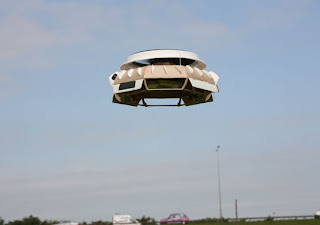
Think "flying saucer" and UFOs or 1950s B movies come to mind (see "Earth vs. the Flying Saucers" or "The Day the Earth Stood Still"). But now researchers have built an unmanned aerial vehicle that looks and acts like the imagined thing.
The disc-shaped device can take off vertically from any surface, land practically anywhere, and if it accidentally contacts a building or cliff, it won't explode into a fireball, like those rascally helicopters.
These features could make the aircraft uniquely suited to flying in urban war zones, aiding with search and rescue in disaster areas, inspecting crops and pipelines, and taking aerial photographs."You can take it down to a foot in diameter and we are told it is fully scaleable up to a large-sized craft," said David Steel, director of GFS Projects in Peterborough, England.
"GFS" stands for Geoff's Flying Saucer, after Geoff Hatton, the engineer and inventor who originally conceived of the idea.
Although flying saucers are a favorite among extra terrestrials, Earthbound engineers have had a more difficult time getting the vehicles off the ground.
Some designs will hover, but they can't move up or down to navigate over a hill or building, for example. Other designs do not lend themselves to maneuverability or steering.
Hatton's design accomplishes both.
The vehicle looks something like an upside-down bowl with a propeller on top. When the propeller spins, air gets pushed down over the outer surface of the bowl. That action creates lower air pressure on top of the craft and higher air pressure below, giving the vehicle lift.
The design makes it easy to incorporate a large payload at the center of gravity, said Holger Babinsky, associate professor of aerodynamics at the University of Cambridge in Cambridge, England.
"You can do it in a helicopter, but you have the blades that stick out a long way and if you want to maneuver in a tight terrain, that's dangerous," he said.
Air flaps around the edge of the saucer prevent it from spinning like a top and allow the controller to steer it.
According to Steel, the saucer is more stable and easier to fly than a helicopter and because it has fewer moving parts than a helicopter, it's easier to build and maintain.
But fuel efficiency could be an issue, said Holger. "That is the number one killer," he said.
The reason is that the fan is relatively small and in a confined space and needs to produce high volumes of air.
"The batteries don't last as long because the amount of power you convert into thrust is not so great because the efficiency is low," he said.
The U.S. Department of Defense has its eye on the saucer and earlier this year awarded GFS with a contract to demonstrate that the craft could hover and maneuver. In fact, the flying saucer did both, flying in winds of more than 10 mph.
This past September, the U.K. Ministry of Defense selected GFS as one of six teams to compete in the Grand Challenge Program, a competition next July for autonomous vehicles. The saucer will be equipped with cameras and infrared technology to find hidden threats along a designated course.
Congratulations, Geoff on effectively desensitizing us to the first real invasion, and thus, sealing our fate.
No comments:
Post a Comment